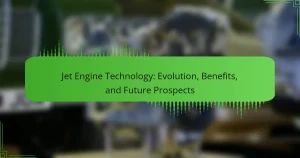Jet engine technology plays a crucial role in modern aviation, offering improved fuel efficiency and performance. This article explores the evolution of jet engines, highlights their benefits, and examines future prospects, including sustainable aviation fuels and hybrid-electric propulsion systems. Key advancements like high-bypass turbofans and the use of advanced materials have transformed the industry, addressing environmental challenges while enhancing operational efficiency.

How has jet engine technology evolved over the decades?
Jet engine technology has significantly evolved, enhancing efficiency and performance. Over the decades, advancements include the introduction of high-bypass turbofans, which improve fuel efficiency by 20-30%. The shift from turbojets to turbofans marked a unique attribute, optimising noise reduction and thrust. Additionally, materials like composite alloys have emerged, offering rare attributes such as increased durability and reduced weight. Future prospects focus on sustainable aviation fuels and electrification, aiming for a greener aviation industry.
What were the key milestones in jet engine development?
Key milestones in jet engine development include the invention of the turbojet in the 1930s, advancements during World War II, the introduction of the turbofan in the 1950s, and the ongoing evolution towards sustainable aviation technologies. The turbojet, developed by Frank Whittle and Hans von Ohain, marked the beginning of modern jet propulsion. Post-war advancements led to increased efficiency and thrust. The turbofan engine, which significantly reduced noise and improved fuel efficiency, became the standard in commercial aviation. Currently, research focuses on hybrid-electric engines and alternative fuels to reduce environmental impact.
How have technological advancements influenced jet engine efficiency?
Technological advancements have significantly enhanced jet engine efficiency through innovations in materials, design, and aerodynamics. Modern engines utilise lightweight composite materials, reducing overall weight and improving fuel efficiency. Advanced computational fluid dynamics allows for optimised airflow, resulting in lower drag and increased thrust. Additionally, the introduction of variable bypass ratios and high bypass turbofans enhances performance across various flight conditions. These improvements contribute to reduced fuel consumption and lower emissions, aligning with environmental regulations and sustainability goals.
What role did military applications play in jet engine innovation?
Military applications significantly accelerated jet engine innovation by driving advancements in performance and efficiency. The need for faster, more powerful aircraft during conflicts led to the development of turbojet and turbofan engines. Military funding and research facilitated breakthroughs in materials, aerodynamics, and propulsion technologies. As a result, these innovations not only enhanced military capabilities but also contributed to commercial aviation advancements, showcasing the dual-use nature of jet engine technology.
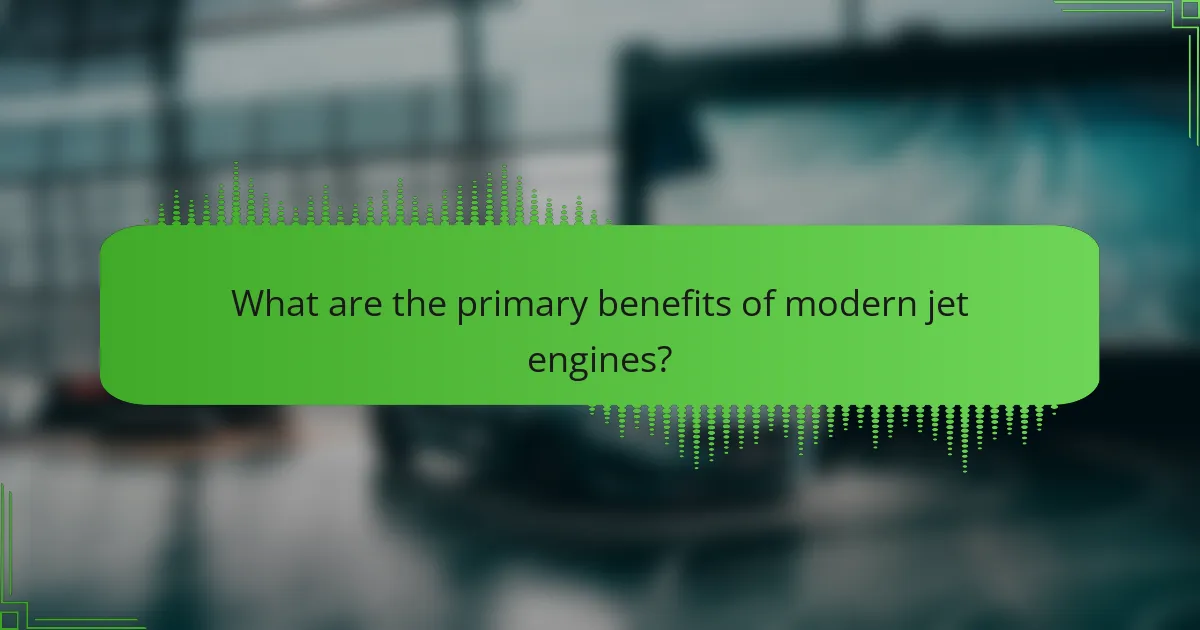
What are the primary benefits of modern jet engines?
Modern jet engines provide significant benefits, including improved fuel efficiency, reduced emissions, and enhanced performance. These engines utilise advanced materials and designs, leading to lighter weight and greater thrust.
Fuel efficiency has increased by up to 15% compared to older models. This reduction in fuel consumption directly correlates with lower operating costs for airlines. Additionally, modern engines are designed to minimise noise, contributing to quieter flight operations.
The use of high-bypass turbofan technology is a key factor in these advancements. This design allows for a larger volume of air to bypass the engine core, improving thrust while reducing fuel consumption.
Future prospects include further innovations in engine design, such as hybrid-electric propulsion systems, which could revolutionise air travel by drastically cutting emissions and reliance on fossil fuels.
How do jet engines contribute to fuel efficiency in aviation?
Jet engines significantly enhance fuel efficiency in aviation through advanced design and technology. Modern engines utilise high bypass ratios, which allow more air to bypass the core, resulting in greater thrust with less fuel consumption.
Additionally, innovations such as variable fan blades optimise aerodynamics, improving efficiency across different flight conditions. The materials used in jet engines have evolved, with lighter and more heat-resistant composites reducing overall weight and enhancing performance.
As a result, the latest engines can achieve up to 20% better fuel efficiency compared to previous generations. This ongoing evolution in jet engine technology promises to further reduce fuel consumption and emissions, aligning with the industry’s sustainability goals.
What environmental advantages do contemporary jet engines offer?
Contemporary jet engines provide significant environmental advantages, including reduced emissions, improved fuel efficiency, and quieter operation. These engines utilise advanced materials and designs that lower nitrogen oxide emissions by up to 50% compared to older models. Additionally, modern engines achieve a 15-20% increase in fuel efficiency, contributing to decreased carbon dioxide output. Enhanced noise reduction technologies further minimise the impact on surrounding communities, making air travel more sustainable.
How do advancements in jet engine technology enhance passenger comfort?
Advancements in jet engine technology significantly enhance passenger comfort by reducing noise, improving air quality, and increasing fuel efficiency. Modern engines utilise advanced materials and design techniques to minimise vibration and noise levels. As a result, passengers experience a quieter cabin environment during flights. Enhanced air circulation systems contribute to better air quality, reducing fatigue and discomfort. Additionally, fuel-efficient engines lead to fewer emissions, promoting a more sustainable travel experience. Overall, these advancements create a more enjoyable and comfortable journey for passengers.
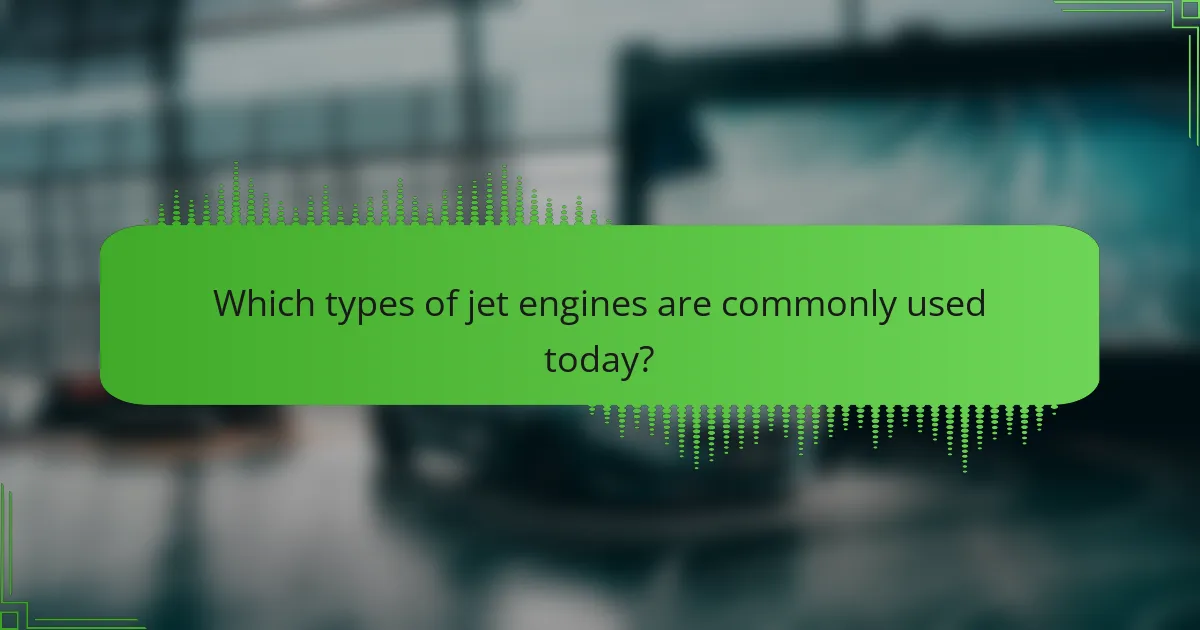
Which types of jet engines are commonly used today?
The most commonly used jet engines today are turbojet, turbofan, turboprop, and turboshaft engines. Turbojets are efficient at high speeds, while turbofans provide better fuel efficiency and lower noise levels. Turboprop engines are used in smaller aircraft for short-haul flights, and turboshaft engines power helicopters and other vertical lift aircraft. Each type is designed to meet specific operational needs and performance criteria.
What are the differences between turbojet and turbofan engines?
Turbojet engines are simpler and lighter, while turbofan engines are more fuel-efficient and quieter. Turbojets excel at high speeds, whereas turbofans provide better performance at subsonic speeds. Turbojets typically have a higher thrust-to-weight ratio, while turbofans offer improved fuel economy and reduced noise levels.
How do turboprop engines compare to pure jet engines?
Turboprop engines are generally more fuel-efficient at lower speeds compared to pure jet engines. Turboprop engines utilise a turbine to drive a propeller, making them ideal for short-haul flights. In contrast, pure jet engines excel at high speeds and altitudes, offering superior performance for long-distance travel.
| Feature | Turboprop Engines | Pure Jet Engines |
|———————-|————————-|————————-|
| Speed | Lower speeds | Higher speeds |
| Efficiency | More fuel-efficient | Less fuel-efficient |
| Best Use | Short-haul flights | Long-haul flights |
| Maintenance Cost | Generally lower | Generally higher |
| Power Source | Turbine-driven propeller | Jet propulsion |
| Altitude Capability | Lower altitudes | Higher altitudes |
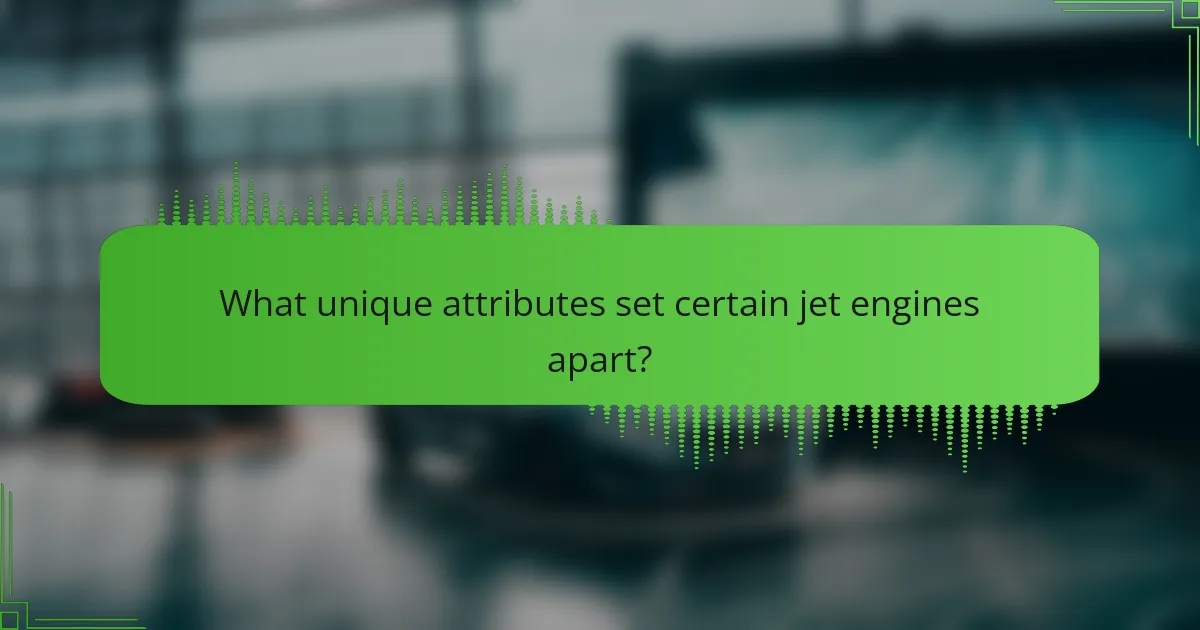
What unique attributes set certain jet engines apart?
Unique attributes that set certain jet engines apart include advanced materials, innovative designs, and specific performance metrics. For instance, some engines utilise composite materials for weight reduction, while others feature variable fan geometry for improved efficiency. Unique thrust-to-weight ratios can also distinguish engines, enhancing performance in various flight conditions. Additionally, noise reduction technologies are increasingly prominent, appealing to environmentally conscious regulations.
What innovations have emerged in high-bypass turbofan engines?
Recent innovations in high-bypass turbofan engines focus on enhanced efficiency, noise reduction, and sustainability. Advanced materials, such as composites, reduce weight and improve fuel efficiency. New aerodynamic designs optimise airflow, leading to increased thrust and lower emissions. Hybrid-electric propulsion systems are being explored to further decrease environmental impact. Additionally, digital technologies enhance engine monitoring and maintenance, improving reliability and performance.
How do hybrid-electric jet engines differ from traditional designs?
Hybrid-electric jet engines utilise both conventional fuel and electric power, enhancing efficiency and reducing emissions compared to traditional designs. These engines incorporate electric motors that assist in propulsion, leading to lower fuel consumption and noise levels. Traditional engines rely solely on combustion, which results in higher greenhouse gas emissions. The integration of battery technology in hybrid engines allows for improved performance during takeoff and climb phases. As a result, hybrid-electric designs represent a significant advancement in jet engine technology, aligning with sustainability goals in aviation.

What challenges does the jet engine industry face in the future?
The jet engine industry faces significant challenges including environmental regulations, technological advancements, and supply chain disruptions. These factors require ongoing innovation and adaptation to maintain efficiency and sustainability.
Environmental regulations are increasingly stringent, pushing manufacturers to develop engines that emit fewer pollutants. Technological advancements, such as the shift to electric and hybrid propulsion, demand substantial investment and research. Supply chain disruptions, exacerbated by global events, threaten production timelines and increase costs.
The industry must navigate these challenges to enhance performance while meeting regulatory standards and consumer expectations. Collaboration among stakeholders can facilitate solutions that balance innovation with environmental responsibility.
How is the industry addressing environmental regulations?
The industry is actively addressing environmental regulations through advancements in jet engine technology. Innovations focus on reducing emissions and enhancing fuel efficiency. Engine designs now incorporate lightweight materials and advanced aerodynamics, minimising environmental impact. Additionally, manufacturers are investing in sustainable aviation fuels, which can significantly decrease carbon footprints. Collaboration with regulatory bodies ensures compliance and promotes the development of greener technologies.
What are the implications of rising fuel costs on jet engine design?
Rising fuel costs significantly influence jet engine design by driving the need for increased efficiency and alternative fuels. Manufacturers focus on optimising engine performance to reduce fuel consumption, which can lead to innovations in materials and aerodynamics. Enhanced efficiency not only lowers operational costs but also aligns with environmental regulations. The shift towards sustainable aviation fuels is also becoming a priority, prompting research into compatible engine technologies. As a result, the industry is evolving to meet both economic and ecological demands.
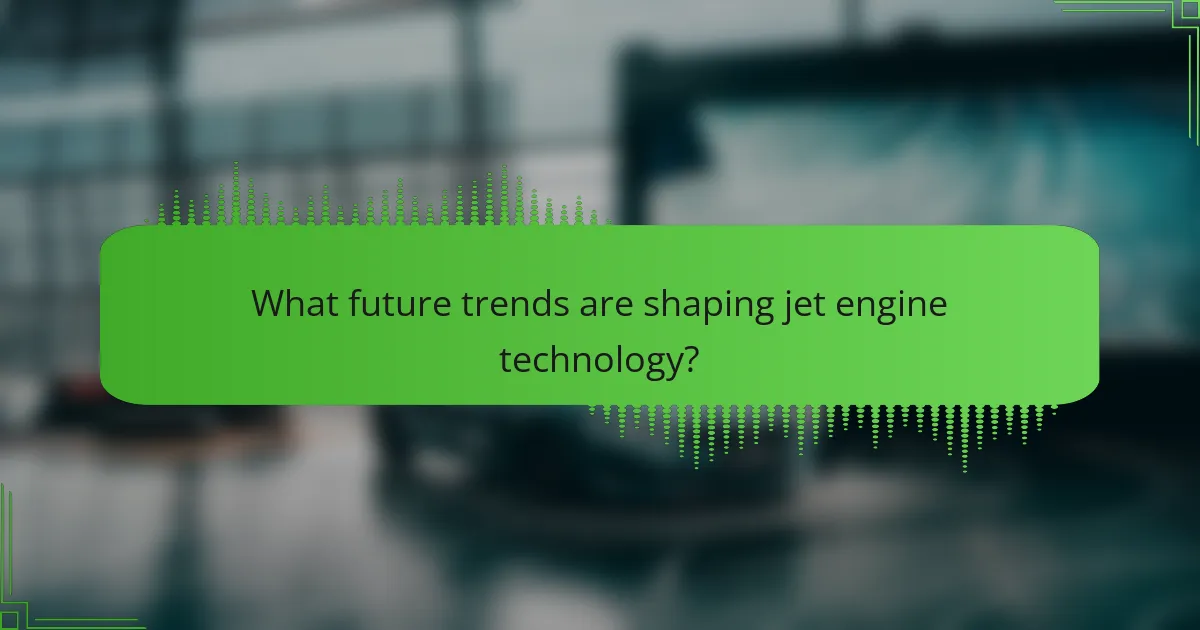
What future trends are shaping jet engine technology?
Future trends shaping jet engine technology include advancements in sustainable fuels, increased efficiency through additive manufacturing, and the integration of artificial intelligence for predictive maintenance. These innovations aim to reduce emissions and operational costs while enhancing performance. The shift towards hybrid-electric propulsion systems is also significant, promising to transform the aviation landscape. As a result, the industry is poised for a more environmentally friendly future, addressing both regulatory pressures and consumer demands for greener travel options.
How might artificial intelligence impact jet engine performance?
Artificial intelligence can enhance jet engine performance by optimising design, improving fuel efficiency, and enabling predictive maintenance. AI algorithms analyse vast datasets to identify patterns and anomalies, leading to better performance metrics. For example, AI can simulate various operating conditions, allowing engineers to refine engine designs for maximum efficiency and reduced emissions. Additionally, AI-driven predictive maintenance can anticipate component failures, minimising downtime and maintenance costs. This integration of AI marks a significant evolution in jet engine technology, promising more sustainable and efficient aviation solutions.
What role will sustainable fuels play in the future of jet engines?
Sustainable fuels will play a crucial role in the future of jet engines by significantly reducing carbon emissions. These fuels, such as biofuels and synthetic fuels, can decrease the aviation industry’s environmental impact. As advancements in jet engine technology continue, incorporating sustainable fuels will enhance efficiency and performance. The shift towards these fuels aligns with global efforts to achieve carbon neutrality by mid-century, making them essential for the future of aviation.
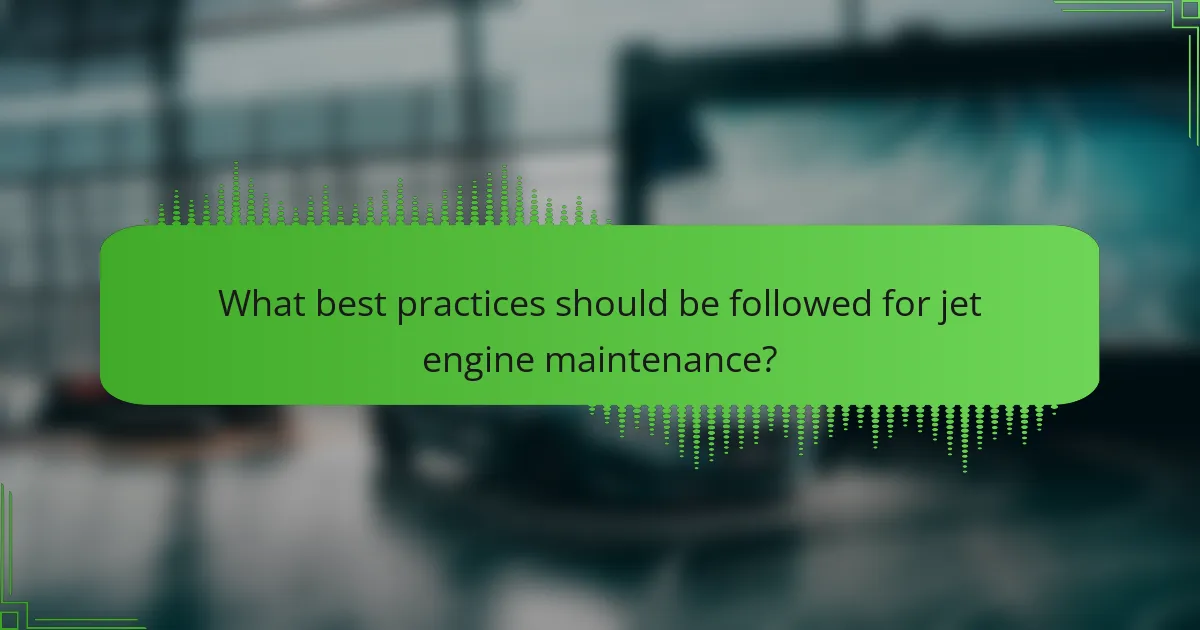
What best practices should be followed for jet engine maintenance?
Regular inspections, adherence to manufacturer guidelines, and use of advanced diagnostic tools are best practices for jet engine maintenance. These strategies ensure optimal performance, safety, and longevity of the engine. Implementing a maintenance schedule that includes routine checks, component replacements, and software updates is crucial. Additionally, training personnel in the latest technologies enhances maintenance effectiveness.
How can operators optimize jet engine performance over time?
Operators can optimise jet engine performance over time through regular maintenance, advanced diagnostics, and performance monitoring. Implementing predictive analytics helps identify potential issues before they arise, enhancing efficiency.
Regular inspections and component replacements ensure that engines operate at peak performance. Utilising real-time data from engine sensors allows operators to make informed adjustments, improving fuel efficiency and reducing emissions.
Investing in training for personnel ensures they understand the latest technologies and maintenance practices. As a result, this knowledge leads to better decision-making regarding engine operations.
Incorporating innovative technologies, such as additive manufacturing for parts, can also enhance performance and longevity. This approach aligns with the evolving landscape of jet engine technology, which increasingly prioritises sustainability and efficiency.
What common mistakes should be avoided in jet engine servicing?
Common mistakes in jet engine servicing include neglecting routine inspections, using incorrect tools, and overlooking manufacturer guidelines. Failing to maintain proper documentation can lead to operational inefficiencies. Additionally, not training staff adequately on the latest technologies can compromise safety and performance. Regular training and adherence to best practices are essential for optimal engine performance.

